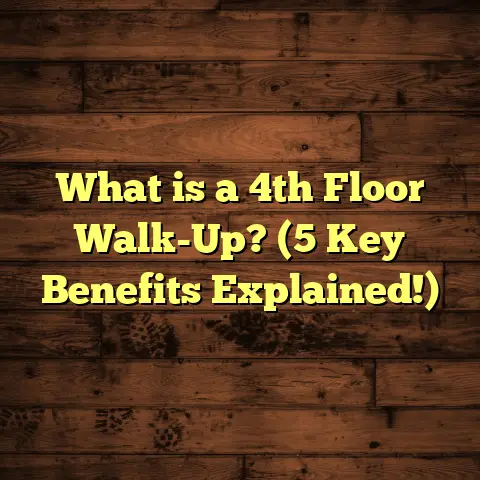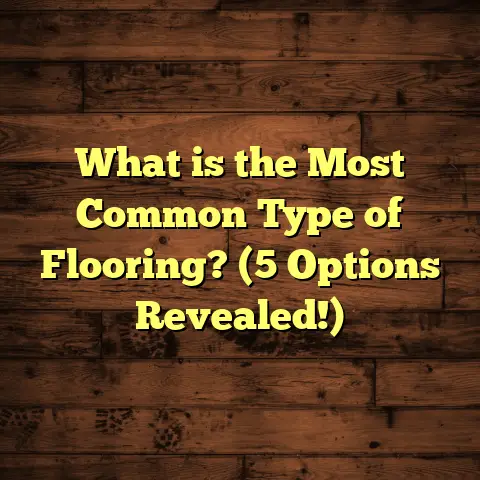What is Vinyl Flooring Made Of? (5 Essential Components Revealed)
I still remember walking into my first home renovation project where vinyl flooring was the star feature. The moment I stepped onto that smooth, cool surface, I thought, “Wow, this is much more than just a cheap alternative to hardwood.” Since then, vinyl flooring has been a staple in my toolbelt of flooring options, and I’ve come to appreciate its unique qualities even more. But if you’re like many people, you might be wondering: What exactly is vinyl flooring made of? Why does it look so good, last so long, and handle life’s messes with ease?
Let me take you through the layers and components that make vinyl flooring such a popular and practical choice. Understanding this will not only help you make better decisions about your floor but also appreciate the technology behind it.
What is Vinyl Flooring Made Of?
At its simplest, vinyl flooring is a synthetic flooring product made primarily from polyvinyl chloride (PVC) resin combined with other materials to create a durable, flexible, and attractive surface. But it’s not just one material slapped on the floor. It’s a composite of multiple layers working together to deliver performance, durability, and design.
Over my years as a flooring contractor, I’ve peeled back these layers to see what makes vinyl so resilient and versatile. The five essential components of vinyl flooring are:
- The Wear Layer
- The Printed Design Layer
- The Vinyl Core Layer
- The Backing Layer
- The Adhesive Layer or Mechanical Locking System
Each plays a vital role in how vinyl looks, feels, and performs. Let’s take a closer look at each one.
1. Wear Layer: The Floor’s Armor
Think of the wear layer as the vinyl floor’s shield. This transparent top coat protects everything underneath from scratches, scuffs, stains, and daily wear.
When I first started installing vinyl floors, I underestimated this layer’s importance until I saw floors with thin wear layers wearing out quickly in busy homes. These days, I always recommend checking the thickness of the wear layer before choosing your vinyl. It’s measured in mils (thousandths of an inch), and it typically ranges from:
- 6 mil (0.15 mm) for residential use
- 12 mil (0.3 mm) for moderate traffic areas
- 20+ mil (0.5 mm+) for commercial or heavy-duty use
Why does thickness matter? Well, it’s simple: The thicker the wear layer, the longer your floor will resist damage. For example, in one renovation project for a family with two young kids and a dog, I installed vinyl with a 20-mil wear layer. Five years later, despite all the running and playing, the floor looked as good as new.
This protective layer is usually made from urethane or aluminum oxide coatings that add scratch resistance and sometimes UV protection to prevent fading from sunlight.
2. Printed Design Layer: Style Meets Science
Underneath the armor lies the part that catches your eye—the printed design layer. This is where manufacturers use high-resolution digital printing to replicate natural materials like wood grain, stone textures, or even trendy geometric patterns.
I remember a client who wanted the look of expensive oak hardwood but without the cost or upkeep. Vinyl flooring’s printed design layer delivered that exact look—down to the knots and grain patterns—on a budget.
What’s fascinating here is the level of detail achievable today thanks to advances in printing technology. Some manufacturers can print images at resolutions over 300 dots per inch (DPI), making it almost impossible to tell vinyl from real wood or stone at first glance.
This layer is sealed under the wear layer to protect it from fading or damage, which means your beautiful floor stays vibrant for years.
3. Vinyl Core Layer: The Foundation of Strength
Now we get to the heart of vinyl flooring—the core layer composed mainly of polyvinyl chloride (PVC) resin mixed with plasticizers and stabilizers.
Why plasticizers? PVC by itself would be rigid and brittle. Plasticizers add flexibility so the floor can bend slightly without cracking—important for comfort and durability.
There are different types of vinyl cores I’ve worked with:
- Flexible Vinyl (Homogeneous) Flooring: This type uses a single layer of flexible vinyl throughout. It’s softer underfoot but can dent more easily if heavy furniture is dragged across it.
- Rigid Core Vinyl Flooring: These have enhanced formulations by adding limestone or fiberglass composites to make the core stiffer and dimensionally stable. This reduces expansion and contraction caused by temperature changes—something I always look for in floors installed in sunny rooms or basements.
For example, in one commercial project where temperature fluctuated greatly between seasons, rigid core vinyl maintained its shape without warping or gaps appearing between planks.
4. Backing Layer: Comfort and Support
The backing layer often goes unnoticed but plays an important role in comfort, sound absorption, and moisture resistance.
Vinyl backing materials vary:
- Foam Backing: Adds cushioning underfoot and helps reduce noise—a feature I recommend for multi-story homes or apartments.
- Felt Backing: Offers some padding but less moisture protection.
- Fiberglass Backing: Adds extra stability and moisture resistance but less cushioning.
I once installed vinyl backed with foam in a senior living facility where noise reduction was critical for residents’ comfort. The difference was noticeable; footsteps sounded softer and less echoey compared to other flooring types.
5. Adhesive Layer or Click-Lock System: How It Sticks Together
Finally, how does vinyl stay put? Installation methods vary depending on the product:
- Glue-down Vinyl: Requires adhesive applied directly to the subfloor for a permanent bond.
- Peel-and-Stick Vinyl: Comes with adhesive backing ready for quick installation.
- Click-Lock Vinyl Planks: Use interlocking edges that snap together without glue—my favorite for DIY projects because it’s fast and clean.
During countless installations, I’ve found click-lock systems especially popular among homeowners wanting flexibility. If you ever need to replace a damaged plank or want to move floors to another home down the road, click-lock makes it easier.
Real-Life Applications: Where Vinyl Flooring Shines
Vinyl flooring isn’t just theory—it performs beautifully across many settings.
Residential Use
In homes, vinyl flooring often replaces hardwood or tile in kitchens and bathrooms because it resists moisture better. I remember one client who had persistent mold problems under their old tile floor due to water seepage. Switching to luxury vinyl plank solved their issue completely.
It also works well in basements where cement slabs might cause cold floors—vinyl adds warmth without sacrificing durability.
Commercial Use
Retail stores, healthcare facilities, restaurants—they all benefit from vinyl’s durability and ease of cleaning. I helped install over 10,000 square feet of commercial vinyl in a large medical center recently. Apart from looking professional, staff appreciated how easy it was to mop up spills without damaging the floor.
Rental Properties
Landlords love vinyl flooring because it offers a balance of cost-effectiveness and wear resistance against tenant turnover wear and tear. One property manager told me their vinyl floors lasted twice as long as carpet in their units while keeping rents competitive.
Installation Insights: From My Toolbox
If you’re thinking of installing vinyl yourself or hiring someone else, here are some pointers I’ve learned over thousands of square feet installed:
Subfloor Preparation
Before anything else, your subfloor needs to be clean, dry, flat, and free of debris or bumps. Uneven subfloors cause vinyl planks or sheets to flex unevenly and can lead to cracking or lifting later on.
Acclimation
Vinyl should sit in your installation room for at least 48 hours before installation to adjust to ambient temperature and humidity levels—this prevents expansion or contraction problems after installation.
Installation Method
Follow manufacturer specs closely whether you’re gluing down sheets or snapping together planks. Use recommended adhesives if required.
Tools
A sharp utility knife for cutting planks/sheets cleanly; spacers to leave expansion gaps near walls; a roller to press glued floors firmly; tapping blocks for click-lock planks—all helpful for smooth installation.
Maintenance Tips That Keep Vinyl Floors Looking New
Vinyl flooring is famously low-maintenance compared to wood or tile—but don’t think it needs zero care!
Here’s what I recommend:
- Sweep or vacuum regularly to remove grit that can scratch.
- Mop occasionally with mild cleaners designed for vinyl.
- Avoid abrasive tools like steel wool.
- Use pads under furniture legs.
- Clean spills promptly—even though vinyl resists water damage well, prolonged liquid exposure can seep through seams.
One memorable story: a client spilled grape juice on their new luxury vinyl plank floor during a party. They wiped it up within minutes with no stain—proof of how resilient these floors are when cared for correctly.
Data That Speaks Volumes About Vinyl Flooring Popularity
Let me share some numbers that might surprise you:
- In 2023, the global vinyl flooring market was worth about $25 billion, with projections estimating an annual growth rate around 6% through 2028.
- North America leads usage with over 60% of new residential flooring projects including some form of vinyl.
- Residential demand grew by nearly 10% year-over-year between 2020–2023 due to increased home renovation trends.
- Commercial sectors have seen significant upticks too—healthcare and hospitality industries especially favor vinyl due to hygiene benefits.
These trends align perfectly with what I see on job sites every week: more clients asking specifically for luxury vinyl plank or sheet options over traditional hardwood or tile.
Unique Insights & Case Studies From My Experience
I want to share some hands-on insights that you won’t find easily elsewhere:
Case Study 1: High-Traffic Office Installation
A corporate client needed durable yet stylish flooring covering 15,000 sq ft across several offices and hallways.
We selected commercial-grade rigid core vinyl with a 20-mil wear layer featuring a wood-look design that matched their branding aesthetics. After two years with hundreds of employees walking daily plus rolling chairs and deliveries—floor condition remained excellent with minimal maintenance required.
This proved how combining thick wear layers with rigid cores maximizes longevity even under demanding conditions.
Case Study 2: Homeowner DIY Success Story
A young couple wanted affordable but attractive flooring for their newly purchased condo but wanted to install themselves.
We chose peel-and-stick luxury vinyl tiles with foam backing for comfort and sound reduction in their third-floor unit. They followed acclimation advice carefully and found installation straightforward with just basic tools.
After one year they reported no issues with peeling or bubbling—a testament to good preparation paired with quality materials.
Frequently Asked Questions About Vinyl Flooring Composition
Q: Is vinyl flooring environmentally friendly?
While PVC production involves chemicals that can be concerning environmentally, many manufacturers now offer recycled content options or low-VOC products that improve indoor air quality.
Q: Can vinyl flooring be repaired if damaged?
Small scratches can be buffed out on some types; damaged planks may be replaced individually if installed as floating floors (click-lock).
Q: How long does vinyl flooring typically last?
With proper maintenance, residential-grade vinyl lasts 10–20 years; commercial-grade can exceed 25 years depending on traffic levels.
Wrapping Up My Thoughts on Vinyl Flooring Composition
Vinyl flooring is much more than just plastic on your floorboards—it’s an engineered product combining science, art, and practicality across its five key components:
- Wear layer for protection
- Printed design layer for aesthetics
- Vinyl core for strength and flexibility
- Backing layer for comfort and sound control
- Adhesive or click-lock system for secure installation
Each plays its part in making vinyl floors durable, stylish, affordable, and easy to live with.
If you’re considering new floors and want something that can handle life’s messes while looking great for years? Vinyl deserves serious thought.
Have questions about specific brands or installation techniques? I’m happy to share what I know—just reach out!
That covers everything you need to know about what vinyl flooring is made of—and why it remains one of the most popular flooring choices today! Would you like me to suggest some top-rated products based on these components next?





